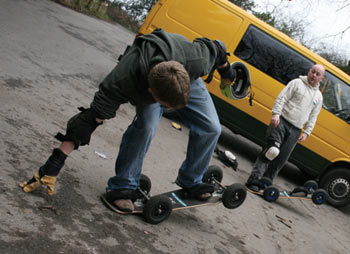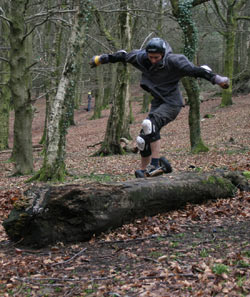Words and Images by J Severs
I lifted my left foot and confidently positioned it in the binding at the rear of the mountain board. The front wheels rose rebelliously into the air, the board seeming to grin at some impending danger. Oblivious, I put my right foot into the front binding and pushed down.
The front wheels hit the mud hard and the board immediately began rolling on its four pneumatic tyres, slowly at first but soon trees were rushing past me like water and I felt the fresh cool air on my grinning face. Cheers echoed around me and the adrenalin began to surge around my body as I threw out an audacious wave –just because I could. This was what I lived for, I was doing it, I was boarding, I was…I was…falling off unspectacularly. After just four yards. For the sixth time.

Mountain Boarding, also called All Terrain Boarding, has been around in basic forms since the 1970s but it wasn’t until the 1990s that the sport properly began to take off. The history is a little sketchy but most sources attribute the sport’s origin to America where snowboarders who wanted something to do in the summer months attached wheels onto their boards. It gradually seeped into the public consciousness and is now a firm fixture at extreme sports festivals.
“The take-up was a little bit slow at first because people didn’t know what they could do, or even what they were!” Nigel explains. “Now they are getting more popular. There are people jumping shopping trolleys, logs, rocks, doing it all.”
Nigel is part of the Be Unlimited Crew, a Mountain Boarding group in South Wales. For my maiden voyage he brought me the essentials: elbow guards, wrist guards, kneepads, padded shorts and a bright yellow helmet. I pulled on the arm protection and plonked the helmet on my head thinking I looked as cool as the other riders. However, as I reached for the kneepads I caught a glimpse of myself in Nigel’s yellow VW “Surfbus”. Where the BU Crew looked like they belonged at an extreme sports festival, I looked like I’d just wandered off the set of Gladiators, that ITV entertainment masterpiece of the 90s. That wasn’t on.
“I’m alright Nige,” I said, shrugging in my best attempt at bravado. “I’ll just stick with the arm and head protection.” They looked at me as if I had just told them I was going to do a bungee jump without the bungee rope. I smiled and they shrugged. I would learn.
The board itself is just under a metre long and is made of fibreglass and maple. There is a foot binding at each end and four nine-inch wheels. It’s basically the love child of a skateboard and a snowboard, and very pretty it is too. As for riding it: “Put your feet as far into the bindings as they will go, keep your weight in the centre but lean to turn. To stop put pressure on the back of the board. If your going to fall off, fall of backwards – it will be less painful. Right. Off you go then”
Easy. Off I went. And down I went. “Ha ha,” I offered. “Whoops.”

I got up. Went through the motions again. And fell off. Again. This time my laugh was less hearty. The others were bombing around, skidding to turn, grinding logs, and traversing through the trees. The two youngest, both 14 years old, had only been boarding for 9 months but were buzzing around like bees. They did fall over – obviously. But, unlike me, that wasn’t all they did.
“Fear is the first thing to overcome, once you have fallen off a few times you get used to it and the fear goes a little bit,” Rob Court, 30, tells me. The BU Crew website has some impressive pictures of him back flipping and doing 360s, “Once you do make it the feeling of that is awesome,” he says.
I don’t get to the point when I’m doing back flips – far from it – but I do begin quite quickly to understand why the sport is so addictive. You are not only locked in a battle with your surroundings, but also with gravity and your own body. Little shifts of balance, for example, have big impacts. Mastering the technique so you can roll just a few yards down a track becomes a monumental achievement that fixes a grin permanently in place on your sweating face. What is great is that you are cheered for this as much as you would be for doing a 360 spin off a 12-foot jump – even at competitions.
“A mountain board allows you to do anything,” Steve Eccles, a rider of five years, enthuses. “You can go on the streets, parks, you can grind anything, go over anything, its like surfing on land. It’s very easy if you have had some board sports experience and it’s easy to pick up if you haven’t.”
This accessibility is making the sport increasingly popular. It is for any age, any gender, or any persuasion. There isn’t the male-club clique you can encounter in Skateboarding, nor the frat-boy mentality that can arise with snowboarding. Instead, the Mountain Board community is a chilled out, all-encompassing one where your willingness to have a go overrides everything else.
There are Mountain Board Centres popping up throughout the UK, but Nigel doesn’t see the point in handing your money over: “You don’t need a centre; all you need is a board, some pads and you can get out on your own. That’s the beauty of the board: you don’t need to pay that man!”
This accessibility is the secret to its growing success. You can simply step out of your front door and the city or countryside is your playground. So hire yourself a board, and get boarding. By the end of the day even I was making it down the easiest of the precarious slopes. I fell off at the bottom, but by this point I was falling off pretty damn spectacularly.
LINKS:
UK Governing body: www.atbauk.org
Scuz Magazine: www.mountainboardmag.co.uk
Manufacturer: www.groundindustries.com

